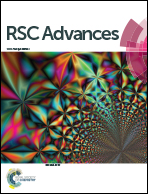Supported CuBr on graphene oxide/Fe3O4: a highly efficient, magnetically separable catalyst for the multi-gram scale synthesis of 1,2,3-triazoles†
Abstract
A superparamagnetic graphene oxide (GO)/Fe3O4–CuBr catalyst was prepared via a simple chemical method and characterized by Fourier transform infrared (FTIR), thermal gravimetric analysis (TGA), transmission electron microscopy (TEM), powder X-ray diffraction (XRD) and X-ray photoelectron spectroscopy (XPS). The GO/Fe3O4–CuBr catalyst could be dispersed homogeneously in water and further used as an excellent semi-heterogeneous catalyst for the one-pot multi-component Cu(I)-catalyzed azide-alkyne 1,3-dipolar cycloaddition (CuAAC) reaction. 1,4-Disubstituted mono/bis-1,2,3-triazoles are readily obtained on a multi-gram scale by the reaction of aryl/alkyl halides, alkynes and sodium azide under microwave irradiation conditions in good to excellent yields. Moreover, GO/Fe3O4–CuBr could be separated conveniently from the reaction mixtures by an external permanent magnet and reused in at least six consecutive runs without a noticeable drop in the product yield and its catalytic activity.


 Please wait while we load your content...
Please wait while we load your content...